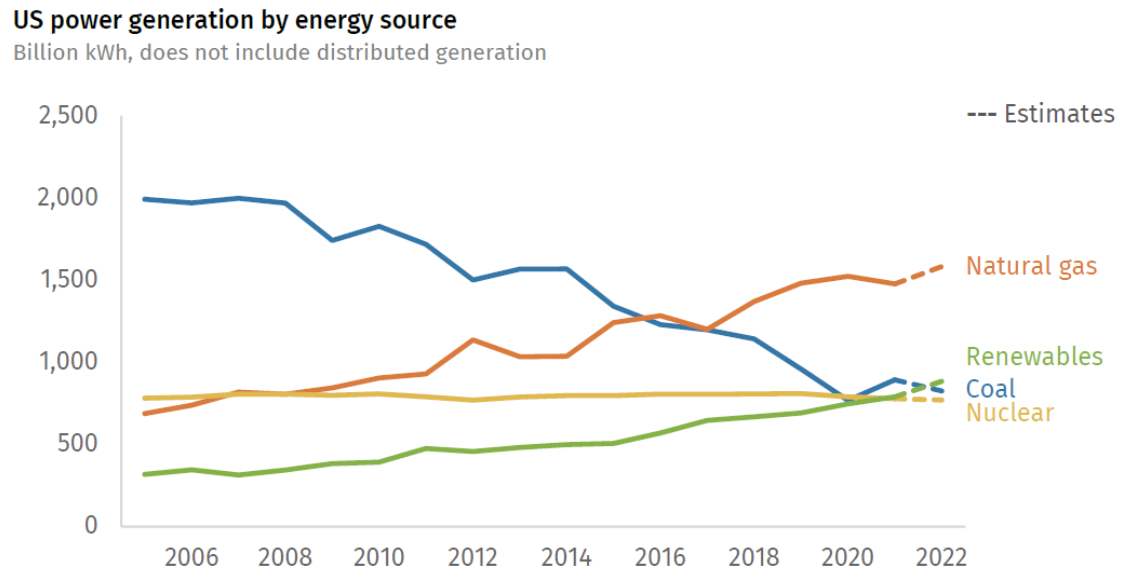According to estimates from the Rhodium Group, U.S. carbon emissions grew by 1.3 percent in 2022, despite growth in renewable energy. (The Rhodium Group is a think tank that often partners with left-of-center philanthropic organizations such as the Rockefeller Foundation and businesses such as BlackRock.) Renewable generation (wind, solar, hydroelectric, etc.) generation surpassed coal power nationwide for the first time in over six decades, with renewable energy of all kinds generating 22 percent of the country’s electricity compared with 20 percent from coal. Along with renewable generation, natural gas power generation also grew, resulting in carbon emissions from electric power generation falling by one percent. President Biden does not want carbon emissions to increase since his goal is to reduce the nation’s greenhouse gas emissions at least 50 percent below 2005 levels by 2030. The recently passed Inflation Reduction Act is purported to support programs designed to reduce emissions by 40 percent, but even if that reduction were to be achieved, emissions will still fall short of Biden’s goal.

Electric Generation
Coal generation is estimated to have declined by 8 percent compared with the previous year, with several factors contributing to the drop, including the retirement of coal-fired generators and disruptions to the railroads that deliver coal to power plants, which hindered power plants’ ability to replenish their coal stocks. The EIA forecasted that these factors contributed to a 19 percent increase in the price of coal for the power sector relative to 2021. Rhodium estimated that coal’s contribution to electricity generation will have reached 20 percent in 2022, a decrease from the 23 percent in 2021. This, incidentally, is the opposite of what is happening internationally, with coal use projected to have reached record highs in 2022.
Despite high Henry Hub prices (65 percent higher than 2021), natural gas consumption for electricity generation increased by 7 percent, largely due to its ability to meet peak demand during record-high summer temperatures. As a result, the share of natural gas in total electricity generation increased slightly from 37 percent in 2021 to 39 percent in 2022.
Renewable energy generation in 2022 increased by 12 percent compared to 2021.
Industry and Transportation
Despite the Biden administration’s aggressive regulations and draconian tactics causing Americans higher energy prices, the United States made little progress last year in reducing emissions in two of its highest-emitting sectors, transportation and industry, which together account for roughly two-thirds of the country’s total greenhouse gas emissions. Industrial emissions are estimated to have increased by 1.5 percent and transportation emissions are estimated to have increased by 1.3 percent. Industrial production was affected by supply chain issues and increasing oil prices, leading to higher production and shipping costs, which led to a limited increase in the manufacturing of goods.
Transportation carbon emissions grew mainly from jet fuel demand as air travel continues to recover from COVID lockdowns. In the first quarter of 2022, fuel demand in the transportation sector, including gasoline, jet fuel, and diesel, increased slightly. But, once the cost of oil and transportation fuels began to increase further, with gasoline prices rising to $5 a gallon in June, demand remained below 2019 levels for the rest of the year, despite lower prices later. Higher costs for everything combined with high fuel prices deflated consumer demand.
The Inflation Reduction Act is expected to provide money to help speed decarbonization at industrial plants and reduce fossil fuel emissions from heavy industry, including cement and steel production. Tax credits for electric vehicles in the legislation are expected to help reduce emissions in the transportation sector due to growth in electric vehicle sales. Electric vehicles are expected to create fewer carbon emissions than gasoline-powered cars, despite coal and natural gas generating about 60 percent of U.S. electricity in 2021.
Buildings Sector
The largest increase in emissions last year (6 percent) came from homes and buildings, which burn fossil fuels such as natural gas in furnaces, hot water heaters and other appliances. Colder-than-average temperatures early in the year led many Americans to increase their home energy use by turning up their heating systems to counter the cold.
Carbon Intensity
While emissions rose in 2022, carbon intensity is estimated to have declined, as it typically has for several decades. Last year, the country’s economic growth, measured in G.D.P., is expected to outpace emissions growth. G.D.P growth is expected to have reached 1.9 percent in 2022.
According to the Rhodium report,
“Over the past few years, the COVID-19 pandemic has shifted the underlying forces that shape the carbon intensity of the economy. In 2019, the downward trend in coal consumption helped to reduce GHG emissions, despite GDP growth. In 2020, the pandemic had a significant impact on the economy, causing GDP to decline by 5.9% and emissions to drop by 10.6% compared to 2019, the largest decrease in emissions since the 2008 recession. However, in 2021, GHG emissions rebounded faster than economic growth—GHG emissions rose by 6.5%, while GDP rose by 5.9%—primarily due to an increase in coal generation and a modest recovery in transport demand. By contrast, in 2022 GDP growth outpaced the increase in GHG emissions.”
Conclusion
Biden’s policies are proving ineffective in reducing carbon emissions since emissions rose by an estimated 1.3 percent in 2022. Rather than move closer to his 2050 goal, Biden brought on financial hardships to Americans by increasing energy prices, which led to higher prices for most goods and higher inflation. Americans await what this year will bring.